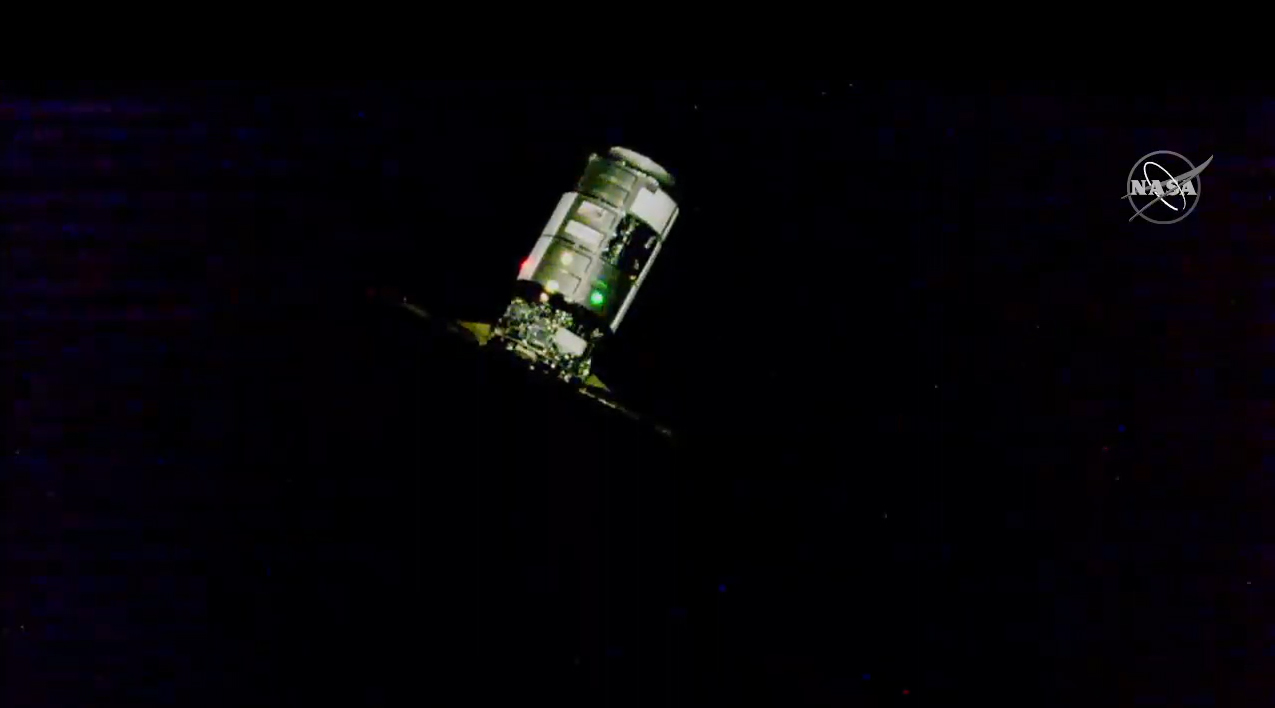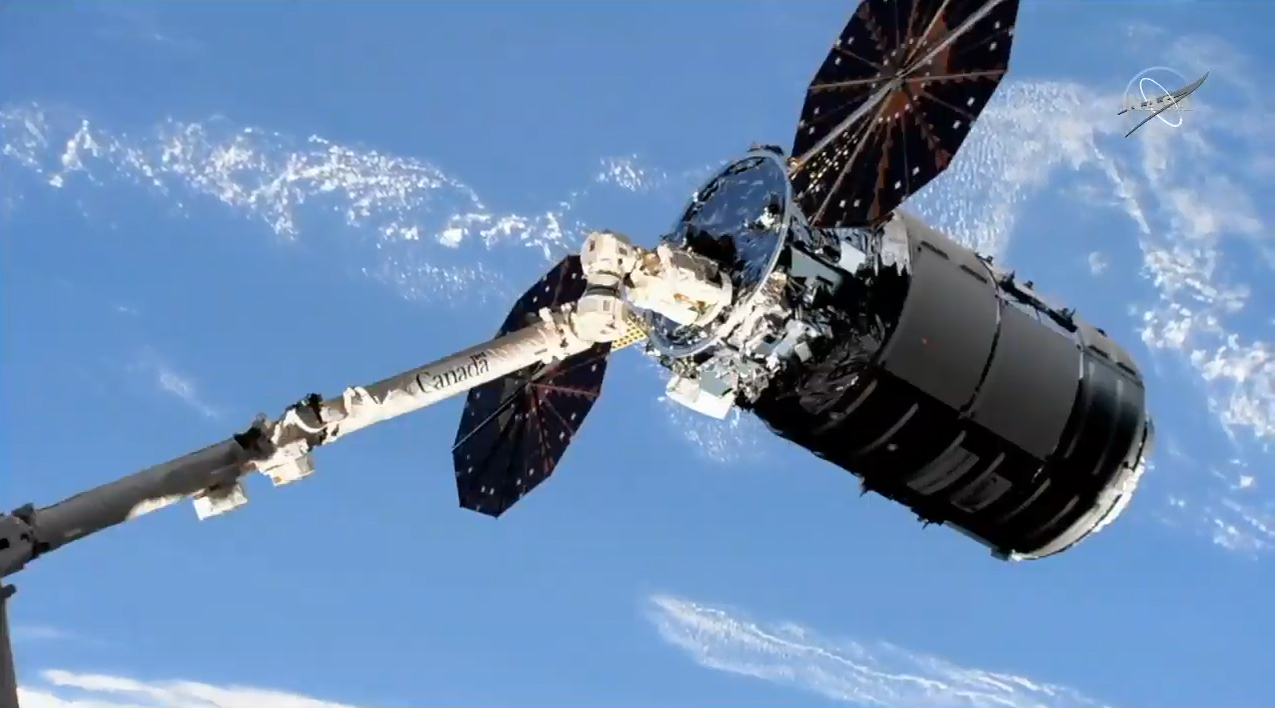Cygnus Cargo Ship Arrives at Space Station with Cookie Dough, Mice and More

An uncrewed Cygnus cargo ship arrived at the International Space Station early Monday (Nov. 4) to deliver more than 4 tons of fresh supplies, including some cookie dough for one tasty experiment.
Astronauts on the station used a robotic arm to capture the Cygnus NG-12 spacecraft, named the S.S. Alan Bean, in honor of the Apollo 12 moonwalker Alan Bean who died earlier in 2018, at 4:10 a.m. EST (0910 GMT) as the spacecraft sailed high above Madagascar. It was installed on the station's Unity module a few hours later.
"As in just 10 days, it will be the 50th anniversary of the launch of Bean's mission, this vehicle honors the legacy of the past, advances our efforts in the present with its delivery of critical International Space Station cargo and serves as a harbinger of the future, with NASA's current plans to return to the moon with the Artemis mission," NASA astronaut Jessica Meir radioed Mission Control after capturing Cygnus. "Congratulations to the dedicated personnel that brought another successful Cygnus mission to fruition."
Video: Blastoff! Cygnus NG-12 Mission Launches To Space Station
Related: Private Antares Rocket & Cygnus Spacecraft Explained (Infographic)
Cookie dough, mice and more
The Cygnus NG-12 mission is delivering about 8,200 lbs. (3,700 kilograms) of fresh supplies to the International Space Station. Its cargo includes a host of science hardware for experiments ranging from a 3D printing recycling demonstration to robotics in space.
Hilton Doubletree has launched a batch of cookie dough to the space station as part of a Zero G Oven experiment by Zero Gravity Kitchen and Nanoracks. The oven aims to bake the first cookie in space to see how astronauts could cook baked goods on future mission. If it works, the experiment will bring the smell of fresh-baked chocolate chip cookies to the space station for the first time.
Related: In Photos: Antares Rocket Launches Cygnus NG-12 Cargo Craft
Breaking space news, the latest updates on rocket launches, skywatching events and more!
Other experiments include AstroRad Vest, a new vest designed to protect astronauts from the harsh radiation environment of deep space, as well as a crew of space mice (technically called Rodent Research-14) that will be used to help scientists study how phases of light and dark affect liver health. On the space station, astronauts see 16 sunrises and sunsets every day as they orbit the Earth. They keep Greenwich Mean Time as they repeatedly shift between Earth's day and night sides.
Cygnus is also carrying cubesats built by students and the National Reconnaissance Office, as well as some much needed gear to repair the $2 billion Alpha Magnetic Spectrometer 2 on the station. The instrument is designed to search for evidence of dark matter and has been mounted to the exterior of the station since 2011. Three of its four cooling pumps have failed over the years and NASA wants to restore it to good health with a series of repair spacewalks later this year.




The S.S. Alan Bean is not the only Cygnus Northrop Grumman is flying in space. In April, the company launched the NG-11 mission in April and it departed the station in August. The spacecraft, called the S.S. Roger Chaffee after Apollo 1 astronaut, has remained in orbit on an extended mission for additional experiments, Northrop Grumman officials have said.
"We're not only flying a Cygnus," Northrop Grumman's Frank DeMauro, vice president and general manager of space systems, told reporters Saturday. "Now we're flying a flock."
Correction: A previous version of this story included an incorrect year for the death of Apollo 12 astronaut Alan Bean. It was 2018, not earlier this year.
- Cygnus Spacecraft Departs Station, Begins New Mission in Orbit
- Space Launch Calendar 2019: Sky Events, Missions & More
- In Photos: SpaceX's Amazing CRS-18 Dragon Flight for NASA!
Email Tariq Malik at tmalik@space.com or follow him @tariqjmalik. Follow us @Spacedotcom and Facebook.

Tariq is the award-winning Editor-in-Chief of Space.com and joined the team in 2001. He covers human spaceflight, as well as skywatching and entertainment. He became Space.com's Editor-in-Chief in 2019. Before joining Space.com, Tariq was a staff reporter for The Los Angeles Times covering education and city beats in La Habra, Fullerton and Huntington Beach. He's a recipient of the 2022 Harry Kolcum Award for excellence in space reporting and the 2025 Space Pioneer Award from the National Space Society. He is an Eagle Scout and Space Camp alum with journalism degrees from the USC and NYU. You can find Tariq at Space.com and as the co-host to the This Week In Space podcast on the TWiT network. To see his latest project, you can follow Tariq on Twitter @tariqjmalik.
